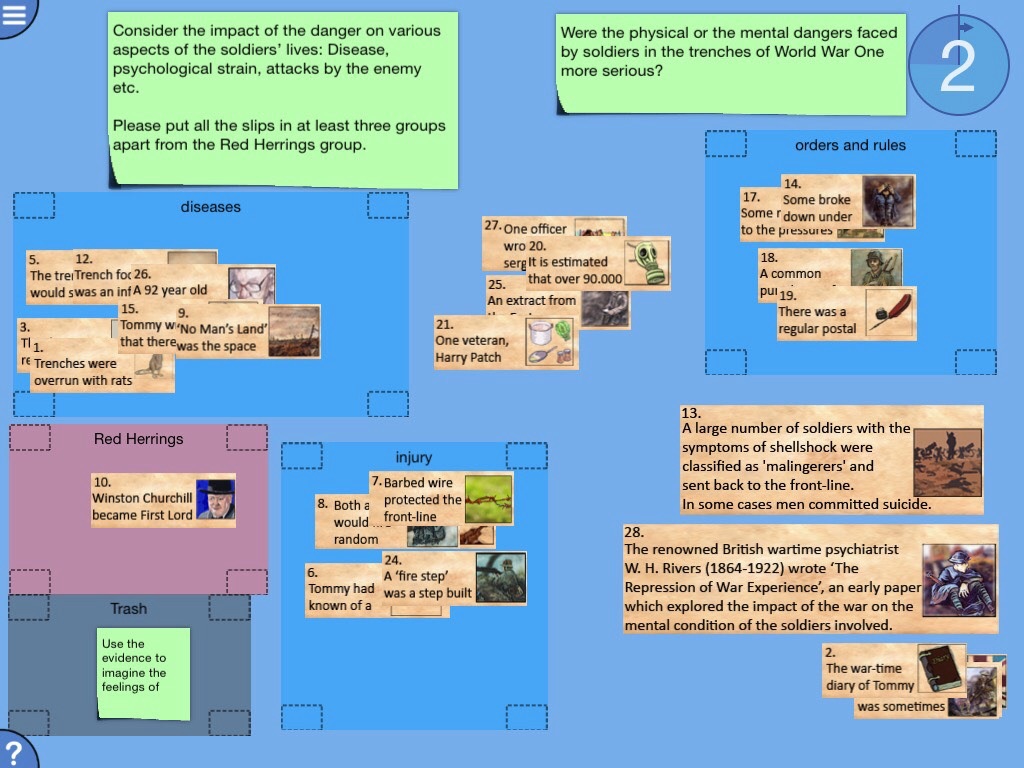
It is a unique app in allowing pairs to work simultaneously on one iPad with a task designed to encourage discussion and higher-level thinking around the National History Curriculum.
Users are given illustrated slips of information which they read, organise into groups and then sequence to represent their thought pattern of how they came to their answer. This is in response to the open-ended question ‘Were the physical or the mental dangers faced by soldiers in the trenches of World War One more serious?’
Students can generate a PDF report of the session which can be shared or printed, plus they can move to a Reflection Stage. This involves sitting as a group, with their teacher, or as a whole class, and playing back the app session to help them reflect on what they’ve understood, discussed or learned. While students do this, it will also help develop their problem-solving, communication and collaboration skills.
This resource is intended to enable students to understand and discuss the details and conditions in the trenches. A particular focus is to imagine them from the perspective of the individual soldier. The war-time diary of Tommy Murphy (a veteran of the Western Front of WW1) has been discovered by his son and so many slips are from his point of view. It is hoped that this will create empathy and engagement that will inform extended writing tasks in History, and in English help to assist with active reading and historical context in books such as ‘Private Peaceful’ and ‘The War Horse’ etc.
Who is Digital Mysteries: WW1 Trenches for?
This app works well with those aged 11-14 (KS3). By having three difficulty levels, it supports differentiation in class and can be suited to varying abilities/levels of knowledge. As the difficulty level goes up, more slips are added (e.g. with abstract information) but there are fewer hints.
What is different about Digital Mysteries?
• Truly collaborative: It is unique in that more than one student can interact with it at once
• Curriculum-mapped: Tasks are directly mapped to the National Curriculum for England
• Retention: Working with information slips from two different perspectives (grouping, then fitting them into a sequence) ensures students remember more
• Higher-level thinking: The multiple discussion points, combined with the task’s open-ended nature, leads to students developing these skills
• Record of learning: Students can interact and have fun with exciting technology then generate a printable PDF report of their session which shows what they’ve done
• Reflection: Sessions are recorded so students can playback and discuss what they’ve done, emphasising the importance of the process as well as the outcome
• Engagement: Mysteries split bulks of information into short snippets which makes it more digestible, plus working with peers leads to higher engagement levels
• Cross-curricular: Tasks come in various topics plus some are cross-curricular in themselves
• Research: We’ve done years of academic research on how to make the most of touch screens for learning
What does a mystery consist of?
• Illustrated slips of information: Including facts on the topic alongside story-based snippets about a particular character and their experiences
• Open question: To maximise the potential of collaboration, discussion, and expression of ideas, the nature of the task is usually open ended
• Extras: Most tasks come with personalised hints for those who need them. E.g. suggestions for grouping or sequencing their slips
• Description: This gives teachers the information they need to plan their session including the curriculum point each task links to, the advised age range and possible learning outcomes
How can I try other mysteries?
Tap ‘Developer Apps’ to view our current range. There are mysteries in subjects including History, Geography and Computing.



